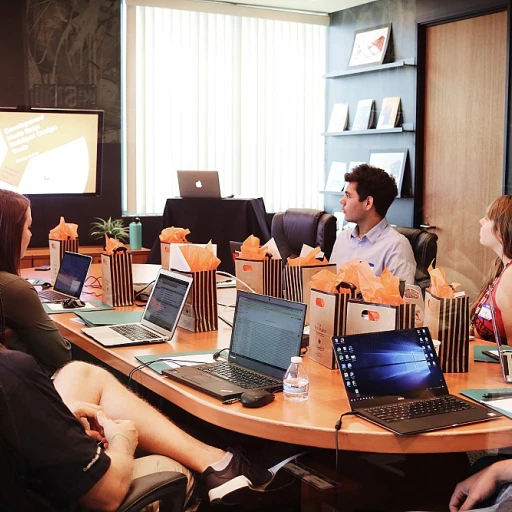
The importance of continuous improvement in reskilling
Why keeping up with change matters
We're living in a world where the only constant is change. Companies need to stay on their toes, especially when it comes to skills. This is where continuous improvement in reskilling comes into play. It helps businesses not just survive, but thrive in an ever-shifting marketplace.
For instance, a McKinsey study reveals that 87% of executives have identified skill gaps in their workforce. That's a hefty number, right? Ignoring such gaps isn't just risky, it's a business disaster waiting to happen.
Adapting to avoid being left behind
Think about Blockbuster. Once a mega-giant in the video rental industry, it crumbled because it didn't adapt to the changing digital landscape. Continuous reskilling ensures that your team’s skills remain relevant, allowing you to stay ahead of competitors who are stuck in the past.
According to Harvard Business Review, companies like AT&T and Amazon are leading the way by investing heavily in reskilling their employees. They’re not just filling today's roles but preparing for the roles of tomorrow.
Employee satisfaction and retention
A happy employee is a productive one. Continuous improvement in reskilling can boost employee satisfaction and retention. In fact, a Gallup poll indicates that businesses with highly engaged teams see a 21% increase in profitability. Who doesn’t want that?
In terms of case studies, take Google. They offer various development programs for their employees. The result? They have one of the lowest turnover rates in the tech industry.
Key statistics that show the impact of reskilling
Impact of reskilling in numbers
Understanding the hard data behind reskilling is key to grasping its importance. Research by the World Economic Forum indicates that around 54% of all employees will need significant reskilling by 2022. The rapid pace of technological advancements, particularly in AI and automation, means that many jobs will evolve, demanding new skills.
According to a McKinsey study, 87% of executives say they’re experiencing skill gaps in the workforce or expect them within a few years. This same study shows that companies investing in reskilling programs have seen a 120% increase in productivity — a clear indicator of the power of continuous learning.
Statistical analysis and real-world examples
LinkedIn’s Workforce Learning Report found that 94% of employees would stay at a company longer if it invested in their career development. This investment pays off, as a PwC report notes that reskilled employees are 20% more efficient in their roles. For instance, AT&T’s Future Ready initiative focused on reskilling its workforce for evolving roles and saw a 50% increase in skill proficiency.
Moreover, IBM’s “SkillsBuild” program reflects the importance of targeted reskilling. It empowered over 500,000 people with the necessary skills for technical roles, resulting in 84% of participants finding employment within six months of completing their training.
Insights from the experts and research findings
Josh Bersin, a renowned industry analyst, emphasizes that continuous improvement in reskilling is not just a strategy but a necessity. He states, “Companies that do not continuously reskill and upskill their people will soon fall behind in this era of constant change.” A Deloitte study concurs, revealing that organizations with structured reskilling initiatives are twice as likely to achieve high performance and innovation.
Additionally, a Gartner report states that by 2025, 50% of all employees will need reskilling due to rapid digitization. This highlights the pressing need for companies to invest in ongoing learning programs to remain competitive.
Ultimately, the stats and insights offer a compelling narrative. The evidence underscores continuous improvement in reskilling as a pivotal driver of workforce sustainability and business success, which directly ties into the strategies and future outlook we'll explore further.
Expert insights on the best methods for ongoing skill enhancement
Exploring powerful methods for ongoing skill enhancement
When it comes to reskilling, continuous improvement is key to staying competitive. Let’s delve into some expert insights on the best methods for ongoing skill enhancement.
Renowned workforce development expert, Dr. Elsa Hillman, suggests integrating microlearning and gamification into traditional training programs. She says, “Microlearning allows for bite-sized, digestible pieces of information, making it easier for employees to absorb and retain new skills.” Similarly, gamification adds an element of fun and competition, making learning more engaging.
Another notable perspective comes from Lisa Fraser, an HR strategist at Harvard Business Publishing. Her emphasis is on personalized learning paths. Fraser explains, “Tailoring learning experiences to individual needs and career goals can significantly boost engagement and effectiveness.”
Studies corroborate these insights. According to a 2021 report from IBM, personalized learning programs improved employee engagement by 46%, and microlearning was found to boost knowledge retention rates by 70%.
Case studies also support these strategies. For example, Google’s ongoing reskilling initiatives rely heavily on microlearning through its ‘Google Primer’ app, now recognized for its success in upskilling employees efficiently. Stated in their report, employees using 'Primer' showed a 30% improvement in job performance within six months.
Thomas Jones, a senior consultant at McKinsey & Company, echoes the importance of real-time feedback mechanisms. “Instant feedback loops help learners to correct mistakes promptly and refine their skills continuously,” he says.
In a rapidly evolving job market, these expert insights and proven methods are crucial. By adopting such techniques, businesses can ensure their workforce remains adept and adaptable, leading to a brighter, more resilient future.
Successful reskilling strategies: case studies
Nissan Motor Company: bridging skill gaps in a competitive market
Nissan Motor Company has been a notable example in deploying cutting-edge reskilling strategies. As part of their business transformation plan, the company launched a comprehensive reskilling initiative that focused on enhancing digital skills among its workforce. According to a report by the company, over 80% of employees went through the program, which resulted in a 30% increase in productivity within the first year source: Nissan Annual Report 2022.
Ibm's approach to life-long learning
IBM has long been at the forefront of employee education and training. Their 'Pathways in Technology Early College High Schools' (P-TECH) initiative collaborates with high schools to prepare students for technical roles. The program has now expanded to include ongoing education for their existing workforce utilizing AI-driven personalized learning paths. IBM reported a 20% decrease in skill gaps through this approach, significantly boosting employee morale and retention source: P-TECH 2022 Impact Report.
Walmart: digital upskilling for a diverse workforce
Walmart launched the Walmart Academy to reskill and upskill its employees, ranging from in-store associates to corporate professionals. An internal survey revealed that over 60% of participants felt more prepared for their roles post-training, contributing to a 15% increase in customer satisfaction scores source: Walmart Academy 2022 Review.
Bbva's employee-centric reskilling programs
BBVA, a global financial services group, rolled out their 'Learnability Quotient' initiative to continuously nurture a learning culture. By leveraging microlearning and gamification techniques, BBVA noticed a 25% growth in strategic skillsets among their staff, which directly influenced their innovation metrics source: BBVA Learnability Quotient Whitepaper.
Shell's investment in future-proofing employees
Shell's commitment to reskilling is evident in their 'Future Skills' program targeting employees potentially at risk of job displacement due to automation. With a focus on digital literacy and data analytics, Shell has successfully reskilled over 70% of its workforce in under three years, positioning itself as a resilient player in the energy sector source: Shell Future Skills Initiative Annual Review 2022.
Trends in reskilling and continuous improvement
Emerging patterns and latest updates in reskilling
In a rapidly changing job market, staying updated with the newest trends in reskilling is essential. A recent report by the World Economic Forum (WEF) highlights that 50% of all employees will need reskilling by 2025 as we move towards more automated and digitized workplaces. This calls for continuous improvement in reskilling strategies.
New models of learning: Online learning platforms, such as Coursera and Udemy, have seen a surge in enrollment. For example, Coursera noted a 640% increase in enrollments from mid-March to mid-April 2020 alone. These platforms provide flexible and accessible learning opportunities, catering to the diverse needs of the workforce.
Micro-credentialing: Companies and educational institutions are embracing micro-credentials, which are short, targeted learning opportunities that allow employees to quickly gain expertise in specific areas. According to a study by LinkedIn Learning, 94% of business leaders agree that a micro-credential should be viewed as evidence of expertise.
Collaborative learning: A Harvard Business Review article points out that peer-to-peer learning can enhance reskilling programs significantly. Employees learn better when they can collaborate and share knowledge with their colleagues, creating an environment of continuous improvement.
Gamified learning experiences: Gamification is becoming a popular trend, as it increases engagement and motivation among learners. A study conducted by TalentLMS found that 83% of employees who undergo gamified training feel more motivated.
Personalized learning paths: The use of AI and big data helps create personalized learning experiences. According to a report by Deloitte, 84% of employers have either updated or are planning to update their learning programs to include personalized learning paths.
Focus on soft skills: The importance of soft skills like critical thinking, communication, and emotional intelligence is rising. Research by LinkedIn found that 92% of talent professionals and hiring managers say soft skills matter as much or more than hard skills.
These emerging trends in reskilling highlight the need for organizations to continuously evolve their learning strategies. Companies like AT&T have already invested heavily in reskilling their workforce, spending more than $1 billion in 2020 alone to train their employees for the future. In another example, Amazon's Upskilling 2025 initiative aims to invest $700 million to provide 100,000 employees with new skills to move into higher-paying, in-demand jobs by 2025.
To stay ahead, it's crucial to follow these trends closely and integrate them into your continuous improvement efforts. This commitment will ensure that your workforce remains competitive and well-equipped for future challenges.
Challenges in implementing continuous improvement for reskilling
Barriers faced by companies in maintaining continuous improvement
Maintaining continuous improvement in reskilling efforts isn't always smooth sailing. One substantial barrier is financial constraints. According to the World Economic Forum, 54% of employees will require significant reskilling by 2022, putting a considerable financial strain on companies.
Then there's the issue of internal resistance. Employees and management can sometimes be reluctant to change, as indicated by a MIT Sloan Management Review study which found that 63% of executives saw culture as a top hurdle in digital transformation efforts. Velenda Charles, a recognized expert in organizational change, notes, "Cultural inertia can paralyze the best reskilling initiatives, often derailing even those with substantial planning behind them."
Poor communication often compounds these problems. Poorly articulated goals and objectives can sow confusion and even doom initiatives. A Harvard Business Review report mentioned that 70% of change programs fail, largely due to inadequate communication and stakeholders’ engagement.
Quality training materials and programs are another sticking point. Without them, employees face subpar learning experiences that impede progress. A 2021 LinkedIn Learning report highlighted that 94% of employees would stay at a company longer if it invested in their learning and development, underscoring the necessity of high-quality content.
Managing synthesis across departments
Ensuring that different departments work together is a juggling act. Organizations often struggle with creating a cohesive strategy that aligns various departments' reskilling priorities. Dr. Rita McGrath, an expert on strategy and innovation at Columbia Business School, emphasizes, "Coordination across departments is crucial. If one department lags, it creates a domino effect hampering overall progress."
Another roadblock is the lack of data-driven decisions. Organizations often hesitate to invest in analytics, despite their potential to refine continuous improvement strategies. McKinsey & Company reported that companies leveraging data and advanced analytics in their employee training programs saw up to a 30% increase in productivity.
It's also worth noting the technical complexities many companies face. Integrating new technologies with legacy systems is often a tough nut to crack. A Capgemini study noted that 78% of executives believe that outmoded technologies hinder innovation efforts, including in reskilling initiatives.
External factors impacting operational continuity
External factors, such as economic downturns and technological advancements [references parts about impact and future outlook], can also derail continuous improvement initiatives. The COVID-19 pandemic, for instance, has forced companies to rethink their approaches drastically on-the-fly. A PwC report mentions that 74% of CFOs noted that they plan to make remote work a permanent option for roles that allow it, significantly impacting reskilling strategies.
Frequent regulatory changes add another layer of complexity. Organizations must stay updated with industry regulations that may necessitate reskilling. This is particularly relevant for sectors like finance and healthcare, where compliance is paramount.
Lastly, keeping up with market demands is essential yet challenging. As new skills become necessary almost overnight, being agile and ready to adapt is non-negotiable. In light of this, continuous improvement in reskilling stands not just as an option but a requirement for businesses aiming to thrive.
The role of technology in continuous improvement for reskilling
Embrace tech innovations for enhancing reskilling
Technology’s rapid growth is reshaping how we approach continuous improvement in reskilling. With digital tools and platforms, employees now have unique opportunities to stay ahead. For instance, a McKinsey report highlighted that 87% of executives are facing skill gaps in their workforce or expect them within a few years.1 Embracing tech can help bridge these gaps.
Artificial Intelligence and Machine Learning: AI-driven tools can personalize learning experiences by analyzing individual learner data, preferences, and areas for improvement. Pioneers like Coursera use AI to recommend courses based on career goals and past learning behaviors.2
Virtual Reality (VR) and Augmented Reality (AR): These immersive technologies provide hands-on training experiences that are otherwise hard to simulate. Companies like Walmart are using VR for training in customer service and compliance, leading to a 30% increase in employee satisfaction.3 AR has similar potential, allowing employees to learn on-the-job with real-time guidance.
Learning Management Systems (LMS): Modern LMS platforms offer tracking, reporting, and management of educational courses and training programs. Systems like Blackboard and Moodle are essential for continuous improvement, enabling ongoing assessment and adaptation of reskilling strategies.4
Gamification: Incorporating game design elements into learning processes can boost engagement, motivation, and retention. Cisco’s use of gamified training modules resulted in a 20% increase in employee engagement with their training materials.5
Considering all these technological advancements, seamless integration is key to successful adoption. A report by Deloitte stated that 81% of companies agree integrating AI with existing systems is the primary challenge.6 So, while tech offers immense possibilities, the real task lies in its careful implementation.
With technology continuously evolving, staying abreast of trends is crucial. Reskilling strategies need to be adaptive and forward-thinking to harness these advancements effectively.
2 Coursera, “Skills Development: The Critical Link Between Education and Employment,” Annual Impact Report, 2021.
3 Walmart, “How VR Is Transforming Training at Walmart,” Corporate News, 2019.
4 Blackboard & Moodle, “Learning Management Systems in Corporate Training,” 2020.
5 Cisco, “Gamification as a Learning Tool,” Cisco Annual Report, 2021.
6 Deloitte, “AI Adoption Insights: Challenges and Strategies,” 2020.
Future outlook for continuous improvement in reskilling
Anticipated changes in the reskilling arena
As we look ahead, the conversation around reskilling is set to undergo significant changes, driven by rapid technological advancements and a shifting job market. According to a report by the World Economic Forum, 50% of all employees will need reskilling by 2025 as automation and digitization continue to transform industries (source: World Economic Forum).
Experts like Josh Bersin, a renowned HR industry analyst, suggest that continuous improvement in reskilling will hinge on personalized learning pathways and leveraging AI to predict future skill needs. Bersin states, 'We are moving towards a model where learning is integrated with work, making it an ongoing, dynamic process rather than a one-time event.'
Increasing integration of AI and machine learning
Artificial Intelligence (AI) and Machine Learning (ML) are expected to play crucial roles in how organizations approach reskilling. AI can help in tailoring learning experiences based on individual needs and learning styles, ensuring that the reskilling process is more effective and efficient. A study by LinkedIn Learning found that 38% of learning and development professionals are confident that AI will significantly impact workplace learning in the next five years.
For example, IBM's SkillsBuild platform uses AI to match employees with the most relevant learning materials based on their career aspirations and current skill levels. This method significantly enhances the personalization and efficacy of reskilling efforts. Vicki Huff Eckert from PwC affirms, 'AI will not only streamline the identification of skills gaps but will also provide targeted, on-demand learning resources to address these gaps promptly.'
The rise of micro-credentials and nanodegrees
Micro-credentials and nanodegrees are gaining traction as they offer a flexible, modular approach to acquiring new skills. These smaller, more focused learning units are particularly useful for continuous improvement in reskilling, allowing employees to quickly adapt to changes and fill specific skill gaps.
Organizations like Coursera and edX offer a variety of micro-credentials in emerging fields such as data science, cybersecurity, and digital marketing. A report by McKinsey indicates that 74% of business leaders believe micro-credentials will be critical in workforce development strategies over the next decade.
Jane Hart, founder of the Centre for Learning & Performance Technologies, notes, 'Micro-credentials and nanodegrees provide a practical, less intimidating way for employees to engage in reskilling. They can build their skills incrementally, without having to commit to lengthy and costly degree programs.'
Shifts in corporate culture and leadership approaches
As reskilling becomes an ongoing necessity, corporate culture and leadership must shift to support continuous learning and adaptability. Organizations that prioritize a culture of learning and encourage experimentation will likely see more success in their reskilling efforts. According to a survey by Gartner, companies with a strong learning culture are 46% more likely to be market leaders and have a high level of employee satisfaction.
Leaders play a crucial role in this transformation. Rajeev Vasudeva, former CEO of Egon Zehnder, highlights, 'Leadership must evolve to embrace a coaching mindset, providing employees with the support and resources they need to continuously grow and develop their skills.'
By fostering an environment where continuous reskilling is valued and supported, organizations can better navigate future challenges and opportunities in the ever-evolving job market. For more insights on the importance of continuous improvement in reskilling, explore our earlier discussion on key statistics and expert methods that illustrate the profound impact of these initiatives.




